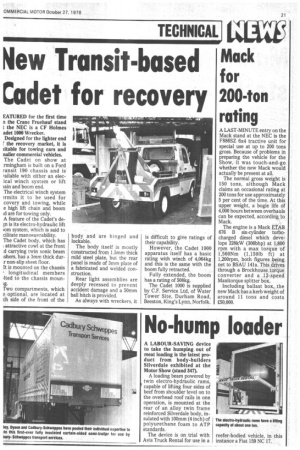New Transit-based Cadet for recovery
Page 23

If you've noticed an error in this article please click here to report it so we can fix it.
EATURED for the first time a the Crane Fruehauf stand t the NEC is a CF Holmes adet 1000 Wrecker.
Designed for the lighter end the recovery market, it is titable for towing cars and nailer commercial vehicles. The Cadet on show at rmingham is built on a Ford ransit 190 chassis and is 7ailable with either an elecical winch system or lift lain and boom end.
The electrical winch system =its it to be used for covery and towing, while e high lift chain and boom id are for towing only.
A feature of the Cadet's den is its electro-hydraulic lift ■ om system, which is said to cilitate manoeuvrability. The Cadet body, which has attractive cowl at the front .d carrying twin sonic beam ishers, has a 3mm thick durr non-slip sheet floor.
It is mounted on the chassis r longitudinal members .1ted to the chassis mounig.
Two compartments, which e optional, are located at ch side of the front of the body and are hinged and lockable.
The body itself is mostly constructed from 1.5mm thick mild steel plate, but the rear panel is made of 3mm plate of a fabricated and welded construction.
Rear light assemblies are deeply recessed to prevent accident damage and a 50mm ball hitch is provided.
As always with wreckers, it is difficult to give ratings of their capability.
However, the Cadet 1000 apparatus itself has a basic rating with winch of 4,064kg and this is the same with the boom fully retracted.
Fully extended, the boom has a rating of 508kg.
The Cadet 1000 is supplied by C.F. Service Ltd, of Water Tower Site, Durham Road, Beeston, King's Lynn, Norfolk.
































































































































































